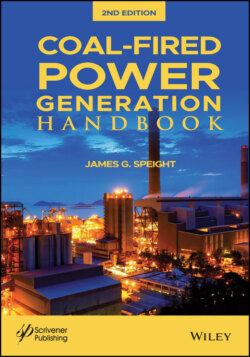Читать книгу Coal-Fired Power Generation Handbook - James Speight G., James G. Speight - Страница 65
3.5 Coal Cleaning
ОглавлениеRun-of-mine coal generally has mineral matter on the order of 5 to 40% w/w and sulfur on the order of content of 0.2 to 0.8% w/w% depending on the geologic conditions and mining technique used. Coal cleaning, therefore, is often required to remove excessive impurities for efficient and environmentally safe utilization of coal. One important purpose of coal preparation is to increase the heating value of the coal by mechanical removal of impurities. This is often required in order to find a market for the product. Run-of-mine coal from a modern mine may incorporate as much as 60% reject materials. In the United States, the coal cleaning is most common at eastern and midwestern mines.
Current commercial coal cleaning methods are invariably based on physical separation; chemical and biological methods tend to be too expensive. Typically, density separation is used to clean coarse coal while surface property-based methods are usually preferred for fine coal cleaning (Davis, 1993; Dodson et al., 1994). In the density-based processes, coal particles are added to a liquid medium and then subjected to gravity or centrifugal forces to separate the organic-rich (float) phase from the mineral-rich (sink) phase.
Density-based separation is commercially accomplished by the use of jigs, mineral spirals, concentrating tables, hydrocyclones, and heavy media separators. The performance of density-based cleaning circuits is estimated by using laboratory float-sink tests. In the surface property-based processes, ground coal is mixed with water and a small amount of collector reagent is added to increase the hydrophobicity of coal surfaces. Subsequently, air bubbles are introduced in the presence of a frothing agent to carry the coal particles to the top of the slurry, separating them from the hydrophilic mineral particles. Commercial surface property-based cleaning is accomplished through froth or column flotation.
Other physical coal cleaning methods include selective agglomeration, heavy and medium cycloning, and dry separation with electrical and magnetic methods (Couch, 1991, 1995). Selective agglomeration and advanced cycloning have the high probability of commercialization, particularly for reducing the sulfur content of coal (Couch 1995). In selective agglomeration, the coal is mixed with oil. The oil wets the surface of coal particles and thus causes them to stick together to form agglomerates. The agglomerated coal particles are then separated from the mineral particles that stay in suspension because they do not attract oil to their surfaces.
